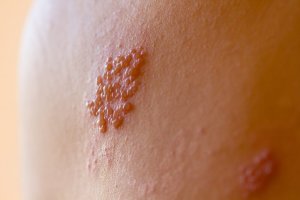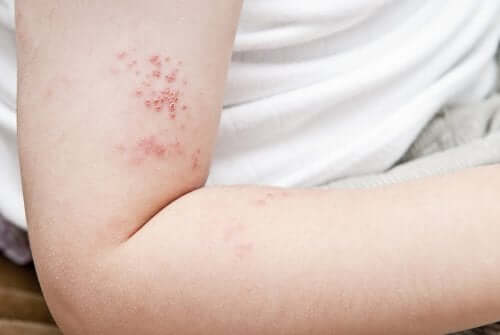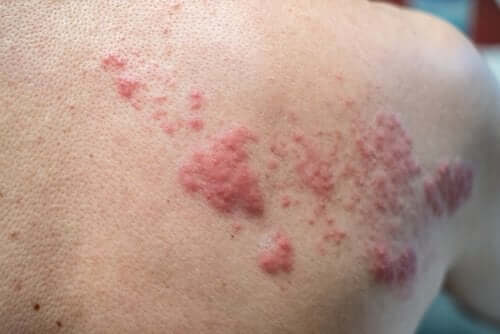Herpes Zoster in Children: What You Should Know

Herpes zoster can appear at any time in life. However, it’s more common and more intense with age. Annually, there are 0.74 cases per 1,000 healthy children under the age of 9. Also, there are 1.38 cases per 1,000 children between 10 and 19 years old.
The main risk factors for herpes zoster in children are:
- The mother having it in the second trimester of pregnancy
- Chickenpox during the first year of life
Let’s see what herpes zoster is and why it occurs. In addition, we’ll talk about the consequences it can have on children who suffer from it.
What is herpes zoster?
Herpes zoster is rare, and it’s usually a benign disease. In children, it usually doesn’t have many complications. However, these complications are more common in adults. Immunocompromised children tend to show more severe symptoms like adults get.
The varicella zoster virus (VZV) causes it, which causes two diseases in humans. The first is chickenpox, which is the primary infection. After recovery, the virus is dormant in the spinal cord. However, it can reactivate, which causes shingles.

Therefore, shingles is the reactivation of the chickenpox virus. Even though chickenpox is very contagious, this doesn’t happen with shingles. It’s much less contagious, and you can only get it from direct contact with skin lesions.
Symptoms of herpes zoster in children
When the chickenpox virus, which remained dormant in the spinal cord, reactivates, it starts to spread along the nervous tract. This is when shingles occurs.
The first symptoms that appear are pain or pruritus. Then, you’ll notice rashes, erythema, vesicles, pustules and scabs that last about two or three weeks. Generally, it comes with other symptoms like fever or malaise.
In more severe cases, it can also cause vision, taste, balance or hearing disorders. This happens when the virus affects the cranial nerves. The most frequent complications are:
- Herpes zoster otic: This appears as a vesicular rash around the ears. Then, it causes paralysis in the face.
- Herpes zoster ophthalmic: This appears as a vesicular rash around the forehead, nose and eyelids. In addition, it causes redness of the eyes.
These special forms aren’t common in children. As we mentioned, children usually experience a much more mild form of this disease.
Treatments
For children, usually you treat herpes zoster by treating the symptoms, in most cases. Specific drugs, like antiviral drugs, are reserved for very risky situations.

If necessary, the antiviral drug for children to treat herpes zoster is acyclovir. Kids can take it orally or by an IV. Antiviral drugs that adults use aren’t good for kids because there isn’t enough research to support using them in children.
Regarding treating the symptoms, they’re mainly aimed at reducing pain, speeding up recovery and preventing complications. Therefore, doctors use non-steroidal anti-inflammatory drugs. In more severe cases, you can also use corticosteroids.
The CDC recommends vaccinating children against chickenpox. However, immunizations don’t prevent shingles.
There have been cases where people get shingles after getting the vaccine. In fact, this happens because varicella vaccine viruses also remain dormant in the spinal cord. Then, they can reactivate when the time comes.
Even so, all prevention is good. We recommend listening to the advice of specialists, and vaccinating your children according to their schedule.
Herpes zoster can appear at any time in life. However, it’s more common and more intense with age. Annually, there are 0.74 cases per 1,000 healthy children under the age of 9. Also, there are 1.38 cases per 1,000 children between 10 and 19 years old.
The main risk factors for herpes zoster in children are:
- The mother having it in the second trimester of pregnancy
- Chickenpox during the first year of life
Let’s see what herpes zoster is and why it occurs. In addition, we’ll talk about the consequences it can have on children who suffer from it.
What is herpes zoster?
Herpes zoster is rare, and it’s usually a benign disease. In children, it usually doesn’t have many complications. However, these complications are more common in adults. Immunocompromised children tend to show more severe symptoms like adults get.
The varicella zoster virus (VZV) causes it, which causes two diseases in humans. The first is chickenpox, which is the primary infection. After recovery, the virus is dormant in the spinal cord. However, it can reactivate, which causes shingles.

Therefore, shingles is the reactivation of the chickenpox virus. Even though chickenpox is very contagious, this doesn’t happen with shingles. It’s much less contagious, and you can only get it from direct contact with skin lesions.
Symptoms of herpes zoster in children
When the chickenpox virus, which remained dormant in the spinal cord, reactivates, it starts to spread along the nervous tract. This is when shingles occurs.
The first symptoms that appear are pain or pruritus. Then, you’ll notice rashes, erythema, vesicles, pustules and scabs that last about two or three weeks. Generally, it comes with other symptoms like fever or malaise.
In more severe cases, it can also cause vision, taste, balance or hearing disorders. This happens when the virus affects the cranial nerves. The most frequent complications are:
- Herpes zoster otic: This appears as a vesicular rash around the ears. Then, it causes paralysis in the face.
- Herpes zoster ophthalmic: This appears as a vesicular rash around the forehead, nose and eyelids. In addition, it causes redness of the eyes.
These special forms aren’t common in children. As we mentioned, children usually experience a much more mild form of this disease.
Treatments
For children, usually you treat herpes zoster by treating the symptoms, in most cases. Specific drugs, like antiviral drugs, are reserved for very risky situations.

If necessary, the antiviral drug for children to treat herpes zoster is acyclovir. Kids can take it orally or by an IV. Antiviral drugs that adults use aren’t good for kids because there isn’t enough research to support using them in children.
Regarding treating the symptoms, they’re mainly aimed at reducing pain, speeding up recovery and preventing complications. Therefore, doctors use non-steroidal anti-inflammatory drugs. In more severe cases, you can also use corticosteroids.
The CDC recommends vaccinating children against chickenpox. However, immunizations don’t prevent shingles.
There have been cases where people get shingles after getting the vaccine. In fact, this happens because varicella vaccine viruses also remain dormant in the spinal cord. Then, they can reactivate when the time comes.
Even so, all prevention is good. We recommend listening to the advice of specialists, and vaccinating your children according to their schedule.
All cited sources were thoroughly reviewed by our team to ensure their quality, reliability, currency, and validity. The bibliography of this article was considered reliable and of academic or scientific accuracy.
- Peñaranda Pérez, I., Peñaranda, L., & Teresa, M. (2003). Herpes zoster infantil. A propósito de un caso. Revista de la Sociedad Boliviana de Pediatría, 42(2), 100-101.
- Peris, J. R., Sáinz, M. M., Calvo, E. C., Nieto, L. G., & Cañas, J. T. (2010). Herpes zóster en pediatría. Revisión de la bibliografía a propósito de un caso. Acta pediátrica española, 68(11), 564-568.
- Alcivar, J. K. S., García, G. O., & Pareyón, L. A. R. (2012). Herpes zoster en un niño inmunocompetente. ACADEMIA MEXICANA DE DERMATOLOGÍA, AC, 56(6), 437-440.
This text is provided for informational purposes only and does not replace consultation with a professional. If in doubt, consult your specialist.








